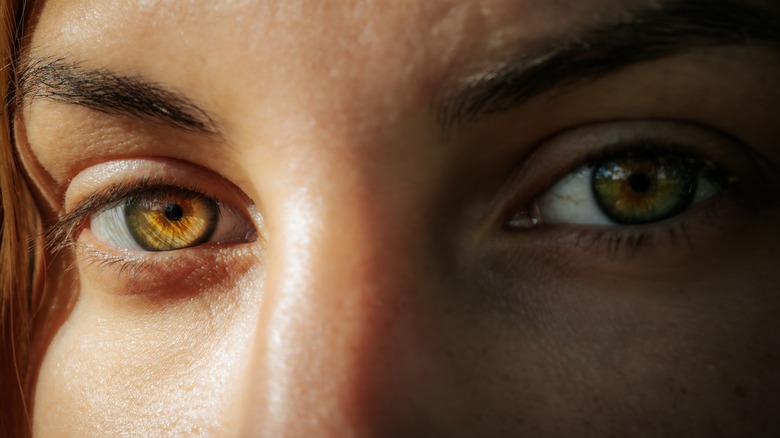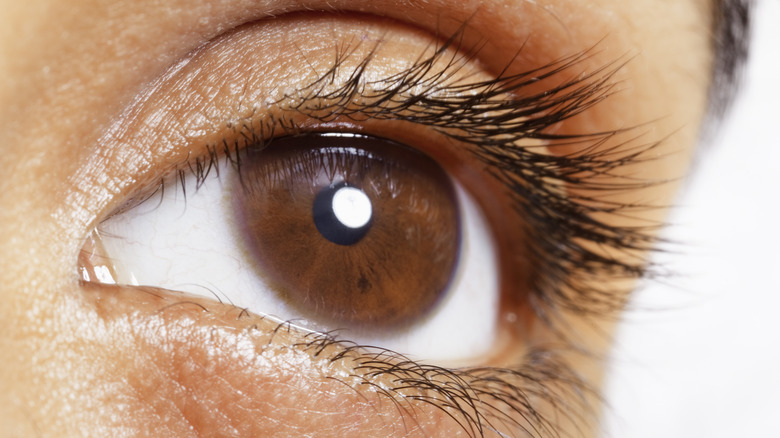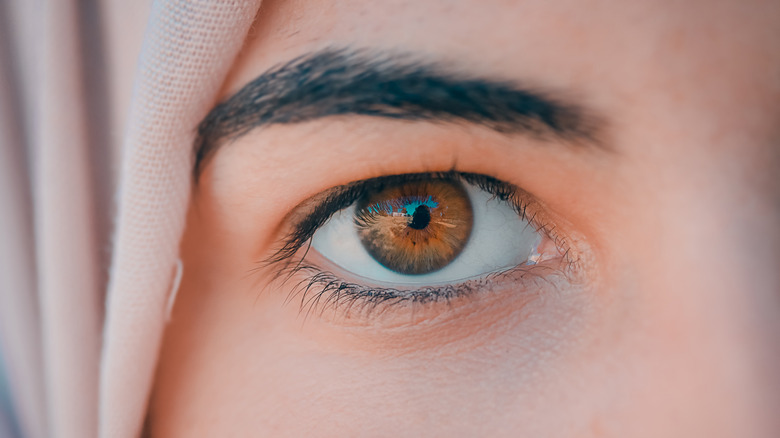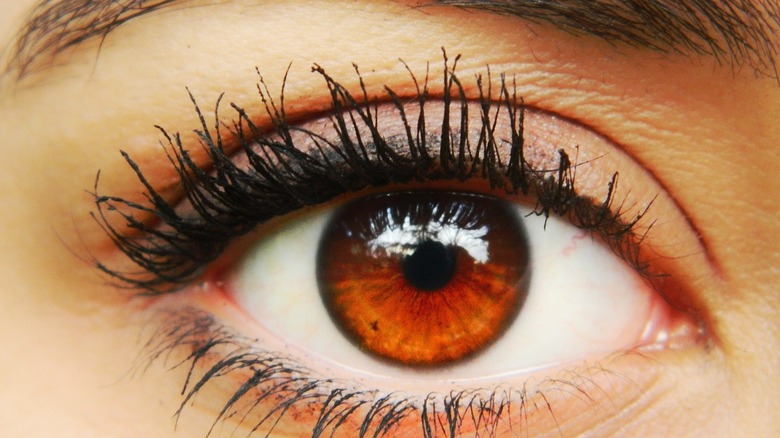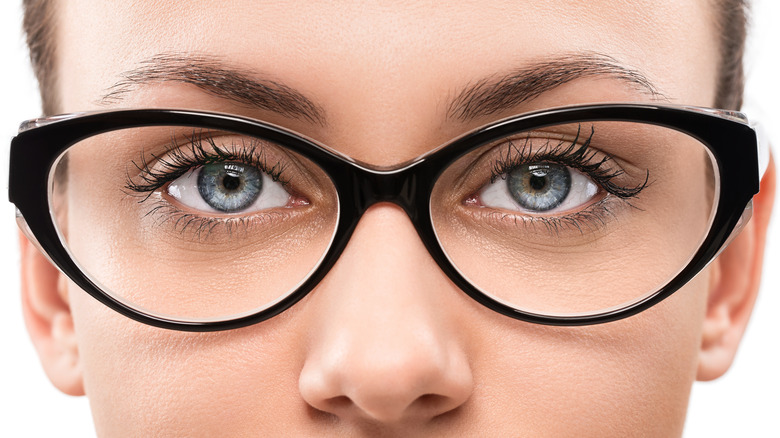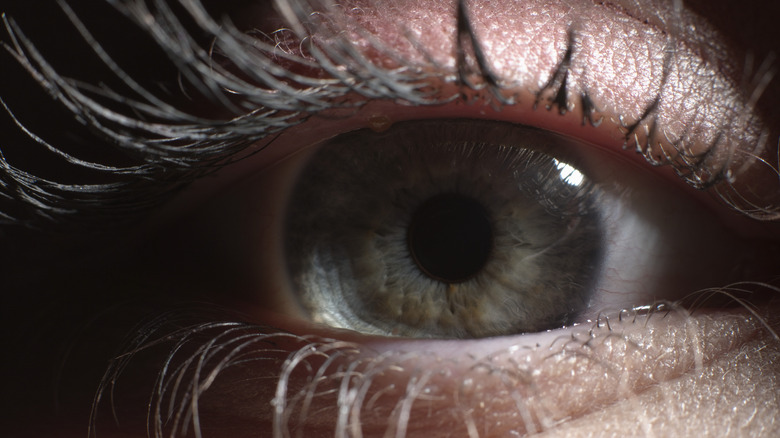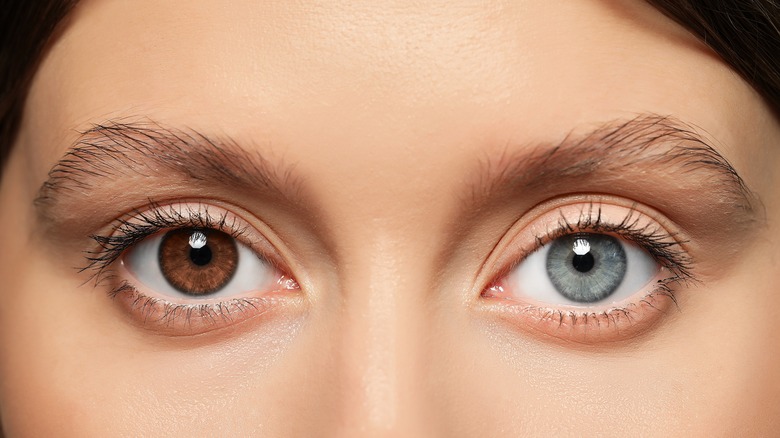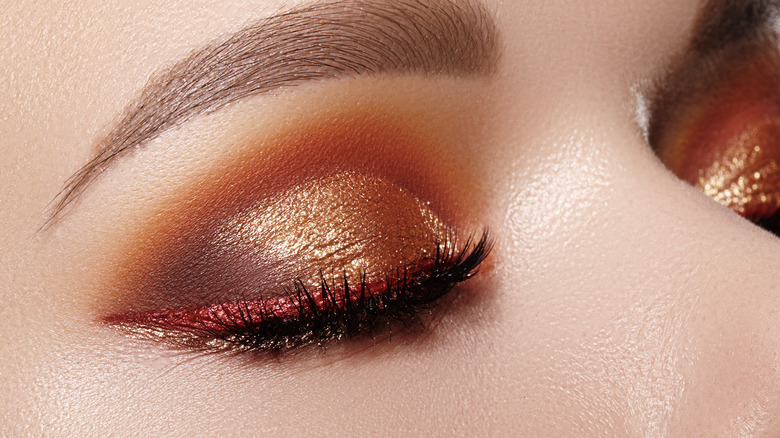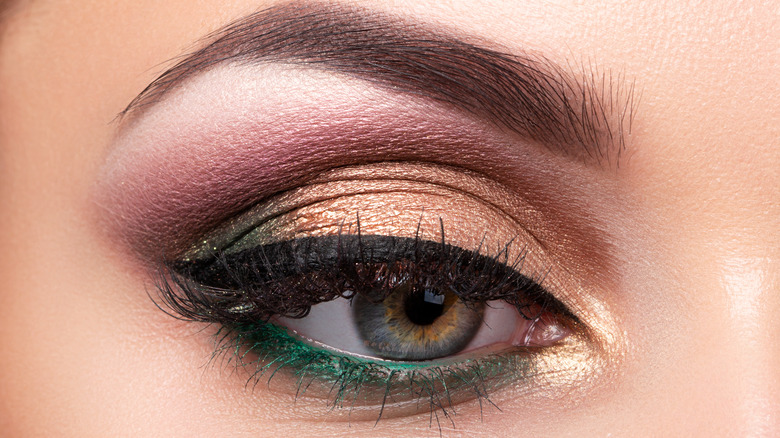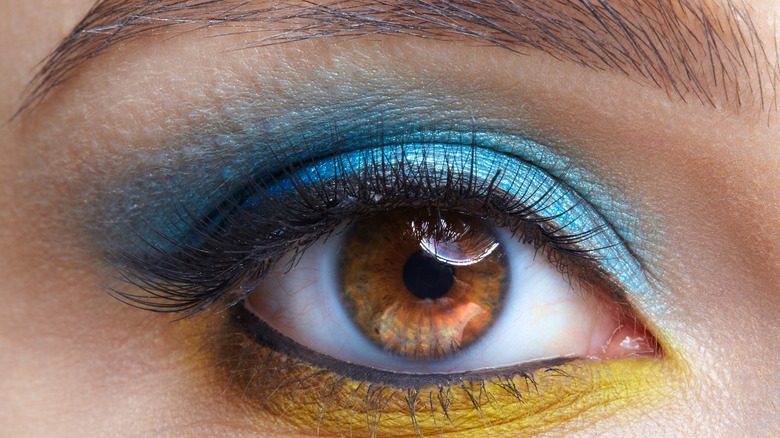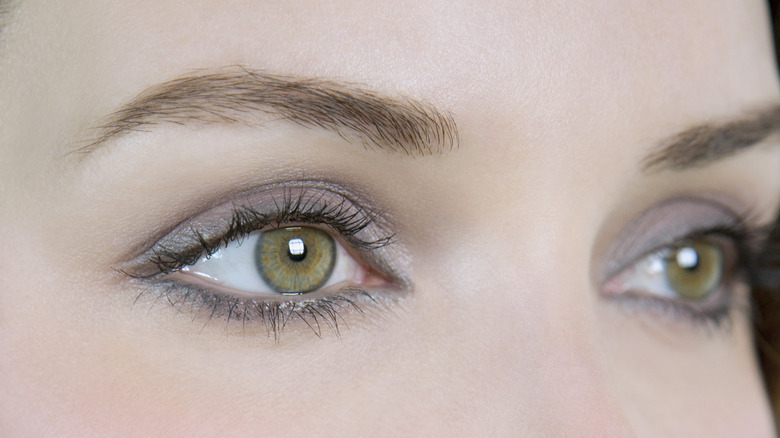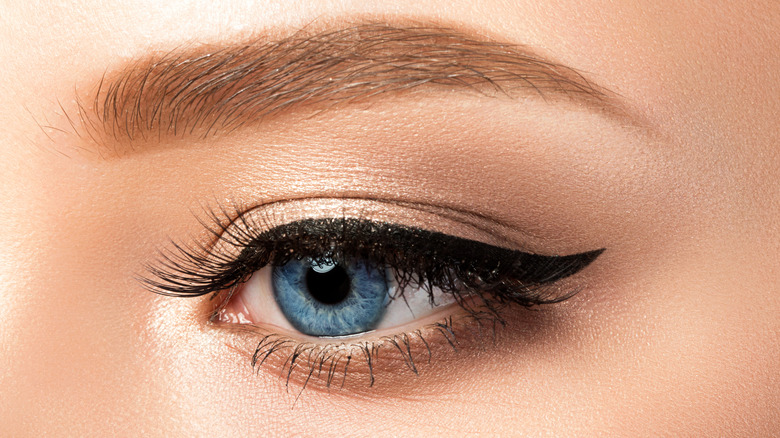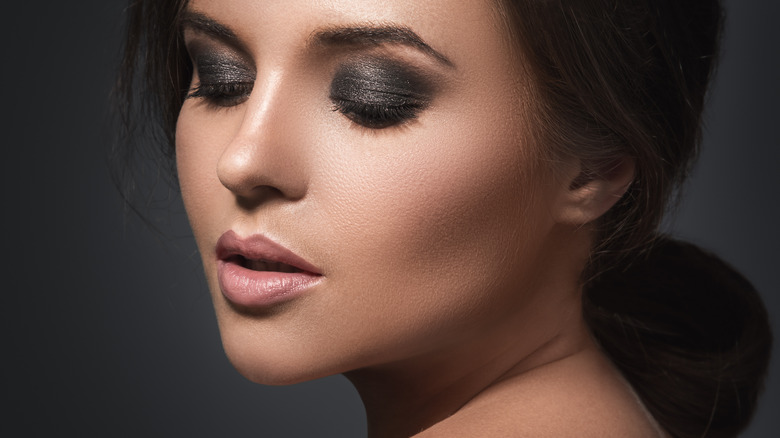The Most Common Eye Colors (& The One Thing You Can Do To Make Them Pop)
They say eyes are the windows to your soul, which is fitting since no two pairs of eyes are exactly alike. In fact, this uniqueness is what makes eyes so beautiful, and your eye color is one distinct feature that people notice right away. While there may be different hues of eye colors, the truth is that most of us are born with either blue or brown eyes. This is because your specific eye color is determined by the amount of melanin, or pigment, you have in your iris — the structure that surrounds the pupil in your eye. The amount of brown or blue pigment you have is pre-determined by a variety of genetic factors, and it develops over time to form one of the six most common eye colors: brown, hazel, amber, blue, green, and gray.
Your personal style, the right hair color and cut, and a complementary makeup look can really bring out your eye color to make it sparkle. Moreover, each eye color is so uniquely created that learning more about it, the genetics behind its creation, and the health effects it can have on your eyes can help you truly embrace your eyes. So, let's explore each of the common eye colors and the one thing you can do to really make them pop.
Brown eyes
There are more than 16 different genes at work influencing our eye color. Amongst the most common eye color produced is brown eyes. Nearly 70% to 80% of people in the world have brown eyes. Scientifically, having brown eyes means that there is simply more melanin present in the iris of our eyes, giving it a dark-brown color. The darkness or lightness of your brown eyes also depends on how much light the concentration of melanin in your eyes allows to enter, as well as how it reflects this light back out. This is why there is such a large range of diversity in how brown eyes appear.
Dark-brown eyes are typically common in people with darker skin tones. This is because the melanin that dictates your skin color is the same type of melanin that is present in your eyes. In fact, brown eyes are most common in warmer regions that receive lots of sunlight because higher amounts of melanin can protect the eyes from sunlight. That's why this eye color is especially prevalent in southern and eastern Asia and Africa.
Hazel eyes
This complex eye color is the perfect mixture of green and brown, making hazel eyes appear to be works of art. They are commonly referred to as light-brown or honey-colored eyes. Babies who are born with blue eyes then, over time, develop a small amount of melanin in their eyes that causes their blue eyes to turn more into a greenish-brown mixture, which produces the appearance of hazel-colored eyes that are not purely blue or brown.
Another reason hazel eyes appear the beautiful color that they do is because of how light scatters in the iris of hazel eyes. Often, you will see hazel eyes having a lighter inner part of the eye than the outer edges due to how melanin is scattered throughout hazel eyes, causing this light-brown color with a green tint. About 5% of the world has hazel-colored eyes, making this eye color a rather unique one most commonly found among individuals that are of European or Middle Eastern descent.
Amber eyes
Amber eyes can be hard to spot, so it can be easy to confuse this color with hazel eyes. This is why they're often left out of the eye colors list. However, one way to spot amber eyes is to notice if the eyes appear more solidly golden or even yellowish rather than tinted with specks of brown and green like hazel eyes. The amber color is a byproduct of a dark-brown melanin that blends over time with another melanin, pheomelanin, that is lighter red and yellow.
Yes, amber eyes are just those perfect golden brown-colored eyes that all the love songs are written about. These jewel-toned eyes have been a hit for decades due to their rarity — they occur in about 5% of the world's population and are especially common among people of Asian, Spanish, and South African descent. Popular celebrities like Justin Bieber, Jennifer Lopez, and Nichole Richie have amber eyes.
Blue eyes
This eye color may seem common, but it's actually rarer than we think. Only about 8% of the world's population has blue eyes. Even though babies are born with either blue or brown eyes, blue eyes are rarer because they are a recessive trait.
While blue eyes come in many different shades, there is no blue pigment present in blue eyes. Rather, the eyes get their blue hue depending on how much light comes in and is reflected out by the iris. This is why blue eyes can look very different depending on the lighting. Since this eye color has less melanin than darker eyes, it is also more crucial to wear sunglasses or shades, as blue eyes can be sensitive to light.
Research from the University of Copenhagen published in 2008 shows that all of us blessed with blue eyes could actually have a single, common ancestor that lived anywhere between 6,000 to 10,000 years ago (via Science Daily). The research suggests it's likely that humans were born with only brown eyes until a genetic mutation took place, causing blue eyes in a far-off ancestor. This event led to the birth and spread of blue eyes. Today, this eye color is especially common in northern Europe.
Green eyes
Did you know that green eyes are a result of a genetic mutation? They're really the perfect mix of brown and blue eyes. While this eye color takes a few months to develop after birth, it has more melanin present than blue eyes. Because of this, as well as how light is reflected from the iris, the eyes appear to be different hues of green, like emerald versus light green.
Only about 2% of the world's population has green eyes, perhaps because this rare eye color occurs only when a small amount of melanin develops in babies born with blue eyes over time. This dazzling eye color can likely be found in people of Scottish, Irish, and northern European descent. According to a 2013 study published in Forensic Science International: Genetics, females are also more likely to have green eyes than males. This eye color is also a popular one for famous movie and book characters like Harry Potter, Catwoman, and Rapunzel.
Gray eyes
Gray eyes may seem rare, however, but about 3% of the world's population has this eye color, making it more common than green eyes. Darker eye colors like gray indicate that there is more melanin in the iris. Often, this eye color can appear blueish-gray in women, and greenish-gray in men. Of course, the appearance of gray eyes can also change to appear lighter or darker depending on the lighting and how much light is reflected from the iris.
More than eight different genes come together to achieve the gray eye color. This color is also unique because the front layer of the iris in gray eyes contains far less melanin than the back layer. This creates a color that is not quite as dark as brown, but also not as light as blue or green. Gray eyes are especially prevalent in people from northern and eastern Europe. It's also common for people to develop a gray tint or ring around the iris of their eyes as they age.
Heterochromatic eyes
It is possible to have a different eye color in each eye, which is called heterochromia. This is a genetic mutation that occurs due to a different distribution of melanin in each eye. While it typically doesn't affect one's ability to see, it can exist at birth, or people can develop it over time as a symptom of another condition, which can include eye injury.
What's so unique about heterochromia is that, just like typical eye colors, it can also come in many different forms. For instance, you can have two fully different eye colors, like one eye that's brown and the other that's green, which is called complete heterochromia. This is different than central heterochromia, where both eyes are one color near the pupil and then change into a completely different color towards the edge, or you can have partial heterochromia where your eyes have uneven distributions of two colors in either one or both eyes. The good news about having different eye colors is that you can try out different makeup looks to complement each eye and mix and match various styles.
Warm makeup tones can make brown eyes stand out
If you have gorgeous brown eyes, you are in luck. Any hue on the color wheel is easy to match with these eyes, which makes picking out eyeshadow colors for brown eyes fairly easy. If you are looking to make your eyes glow, then warm tones like brown, gold, red, and yellow are the obvious option. "Gold-toned eyeshadows are my go-to when searching for a color to accentuate brown eyes," makeup artist Ashely Gomila told IPSY. Even professionals agree that not only are warm tones alluring, but they also greatly complement your rich brown eye color, making your eyes look enchanting.
Since brown eyes come in many variations, choosing the right warm-toned makeup is important. If you have lighter-brown eyes, tones of champagne or bronze can have enough of a hue to create a glamorous look without overwhelming your eyes. You can also add a fun liner color like red to elevate your look. Meanwhile, for rich chocolatey eyes, you can play around with dark-brown eyeshadow. To take your dreamy look to nighttime, add black winged eyeliner to add more depth to your eyes.
Green eye makeup can make hazel eyes shine
If you possess hazel eyes, look no further than hints of green to make your eyes come alive. Now it may seem difficult to incorporate an obscure color like green into your everyday look, however, this color can definitely add vibrancy and bring out the green hints or specks in your eye color. To incorporate this color into an everyday look, try to reach for earthy tones in your makeup. This can look like a light dash of green liner on your waterline and some brown or nude lipstick.
If you're really looking to make your hazel eyes stand out on a night out, a glittery emerald eyeshadow will definitely do the trick. If you want something more subtle, a colorful brown or green mascara can also be fun to play around with. The skin is equally as important to think about when trying to accentuate your hazel eyes. "Using deep tones on the skin emphasizes bone structure and warms the skin to accentuate your hazel eyes," celebrity makeup artist Gina Brooke told Huda Beauty.
Wearing blue can brighten up amber eyes
Amber eyes are known for their golden or yellow tint which makes this eye color appear extra adventurous. While this eye color shines on its own, wearing different shades of blue both in your makeup and in your outfit can further help it glisten. It's no secret that blue is a complementary color to yellow. Perhaps this is why this color pairs so well with amber eyes. The contrast between the hint of gold in the amber eye color and the pop of blue can make this eye color stand out regardless of your skin tone.
Bright shades can help accentuate this eye color. A touch of blue eyeliner along with some shimmering gold or bronze eyeshadow can also add some warmth to your makeup. Be sure to add mascara or even falsies for the extra drama. If blue is not really a color you love to wear, purple tones could be another complementary color to your golden eyes. Sticking to the blue or purple color family can really take amber eyes that extra mile and give you the ultimate shine that you might be looking for.
Stick to red and purple eyeshadow to make your green eyes pop
Just like yellow and blue, red is the ultimate complementary color partner to green. This means that all shades of red, pink, plum, mauve, and purple are fair game makeup colors for green eyes. Luckily, these eyeshadow colors can successfully make green eyes pop all while adding a romantic touch to your date-night look.
For darker green or emerald eyes, darker hues like burgundy or plum can help accentuate your eyes and make them stand out. On the other hand, if you have lighter-green eyes, then softer colors like lilac, mauve, or pink, can be better suited for your eyes. Red lipstick is also a great way to contrast your green eyes and make them pop. Just be sure to keep the eyeshadow as neutral as possible if you do opt for some color on your lips. This will keep your green eyes balanced with your lips, without being overwhelming. Since green eyes are the most unique eye color, they don't need much as they are already striking on their own.
Black eyeliner and blue eyes are a match made in heaven
Whether your irises are the lightest shade of blue or as deep as the ocean, black eyeliner is meant for this eye color. Because black and blue contrast each other so well, having black eyeliner can accentuate blue eyes and give them the ultimate dreamy look.
Rather than bold eyeshadows to bring out your eyes, opt for different types of eyeliner looks that complement blue eyes and add vibrancy. For instance, a simple cat eye can be an elegant daily choice to subtly bring out your blue eyes. For a sensational evening look, a smudged black eyeliner can give them more definition, especially if you have darker-blue eyes. If you feel that black is too intense for you, beauty expert Nina Sutton suggests mixing blue with black. "For eyeliner or mascara, try navy instead of black for a dramatic yet less intense look," she told SheKnows. This is especially great to help lighter-blue eyes sparkle just the right amount.
Smokey eyeshadow can make gray eyes look alluring
Did you know that gray eyes are considered the most attractive eye color? That's right, according to a survey conducted by 1-800 Contacts, gray eyes received the highest attractiveness ranking, meaning that the 1,000 respondents of the survey found gray eyes to be the most appealing of all the eye colors. Interestingly enough, smokey eyeshadow is also often regarded as sultry and appealing. The cool-toned colors of the shadows and the smudged look can be the perfect combination to pair with gray eyes.
In order to achieve a flattering smokey eye, simply opt for a neutral-toned eyeshadow color that is slightly darker than your eyelids. You can pair this with a matching darker color in the crease or folds of your eyes, like a light gray or brown. Once this color is blended in with your base shade, you can skip to the key step that'll make your eyes pop — smudged eyeliner.
Even if you are not a makeup pro, adding a smudged shadow liner can be easier than you think. All you need to do is take some black eyeshadow and go in with an angled makeup brush to lightly line the top of your eyes as if you were drawing eyeliner. If you really want your gray eyes to appear alluring, you can even add some kohl liner to your waterline and some silver sparkles on your lid to take the look to the next level.
